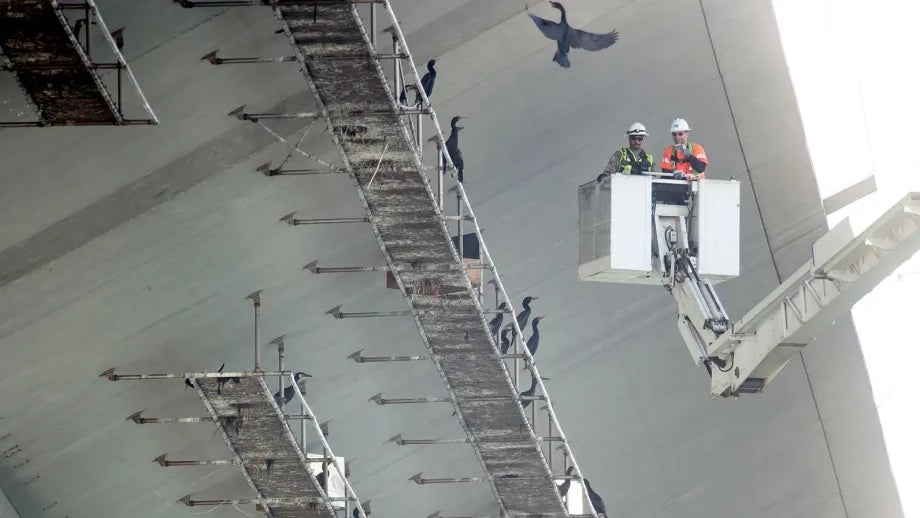Cormorants Flock to Nesting Platforms on New East Span
If you build it, they will come…eventually. The colony of Double-crested Cormorants that long made its home on the old East Span of the San Francisco-Oakland Bay Bridge finally found its Field of Dreams on the Skyway section of new East Span last month, when the first pair of the gangly black seabirds landed on the specially-designed nesting platforms that had been awaiting their arrival since the Skyway’s completion a decade ago.
Knowing that the planned demolition the old East Span would displace more than a thousand cormorants who nested, rested and roosted on the crossbeams beneath the bridge’s truss section, designers of the new East Span included a new home for the birds: some 6,000 square feet of stainless steel platforms tucked below the twin roadway decks. Construction of the platforms was a requirement for Caltrans to secure construction permits for the new bridge as well as to comply with both state and federal endangered species acts and the Migratory Bird Treaty Act. All the cormorants had to do was fly the short distance from the old bridge to the new. But the birds would not budge.
So Caltrans installed decoys to lure the cormorants into joining their brethren to the north. Nothing. Naturalists sweetened the pot with mirror boxes on the platforms that allowed passing cormorants to see themselves in their new home. Still nothing. Artificial nests fashioned from old holiday wreaths attracted nary a new arrival. Nor did an electronic audio system that played an endless string of cormorant come-ons. As dismantling of the old truss section got underway last year and the cormorants’ old habitat began shrinking, the birds still refused to relocate, opting instead for ever-denser occupation of the old neighborhood. When the last of the old truss sections was removed late this March, the cormorants seemed to have vanished.
For days, the bay was enveloped in a fog of mystery. Where had the cormorants gone? No one quite knows the answer. But the first break in the case came in early April as the annual nesting season began and a video monitoring system captured the landing on one of the platforms by a pioneering pair of the puzzling pescetarians. Word of the spiffy waterfront condos appears to have spread quickly — if late — among the cormorant community. By mid-May, estimates of the colony’s population had swelled to more than 700, with reinforcements arriving daily.
“The Bay Bridge cormorant colony is one of the largest in all of Northern California,” said Caltrans Environmental Compliance Manager Stefan Galvez. "The successful relocation of the community to the nesting platforms on the new East Span is an important milestone for ensuring the permanence of the cormorant population in San Francisco Bay.”
As the financing agency for the new Bay Bridge East Span, MTC's Bay Area Toll Authority played a major role in designing and overseeing construction of the span.
— John Goodwin
Submit your comment
In order to receive a reply to your comment, please provide an email address.


This is good news! I read about the Cormorants' situation in Bay Nature magazine and I know a whole lotta people were hopeful they'd settle under the new bridge. Glad to hear they're doing just that.
CONGRATULATIONS! Colonial nesting birds have evolved to be stubbornly site faith and it is not an easy nor a simple matter to convince them to adopt a new nesting context. We're thrilled these amazing birds have a safe and suitable spot to raise their families underneath the new span. Bravo, Caltrans: this is such encouraging news for sustaining our region's Cormorant population!